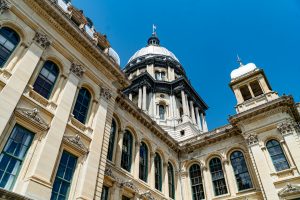Latest forecast still shows enough revenue to fund Pritzker budget
By Jerry Nowicki Capitol News Illinois — May 4, 2023
State Capitol of Illinois, Springfield
SPRINGFIELD – The state’s Commission on Government Forecasting and Accountability has decreased its current-year budget forecast by $728 million, erasing much of a once-predicted surplus that had led Gov. J.B. Pritzker to float the idea of tax cuts earlier this spring.
While the commission’s $51.2 million estimate is now 1.2 percent below its estimate from early March, the impact on Pritzker’s budget proposal is relatively small because the governor’s plan relied on a more conservative estimate.
“Responsible fiscal decisions have led to surpluses allowing us to pay off debt, save for our future, and let us prepare for the possibility of a revenue slowdown,” Pritzker spokesperson Jordan Abudayyeh said in an email. “The governor will continue to work with the General Assembly to pass a responsible balanced budget that makes necessary investments while living within our means.”
COGFA’s Fiscal Year 2023 estimate is now about $183 million below the Governor’s Office of Management and Budget’s estimate that was included in Pritzker’s February proposal. Pritzker’s updated FY 2023 budget, however, had planned to spend slightly less than the new COGFA estimate.
If final revenues mirror the new COGFA estimate, it would, however, mean there’s little to no current-year surplus beyond spending already proposed by the governor as lawmakers craft a final spending plan with two-and-a-half weeks to go in the spring legislative session.

Illinois Department of Revenue Director David Harris (IllinoisChannel.org)
The financial picture for the upcoming Fiscal Year 2024 is also largely unchanged by the new report. COGFA’s $50.4 million FY 24 estimate is $800 million above the proposed $49.6 billion spending level in Pritzker’s February plan.
The latest COGFA report echoes a word of warning that Illinois Department of Revenue Director David Harris gave to a Senate appropriations committee last week.
“Looking ahead to FY 24, I would simply encourage caution. I think the governor’s budget that was introduced is accurate,” he said.
The Pritzker administration, Abudayyeh noted, had predicted a revenue slowdown. So had COGFA, but the monthly report noted that the drop of more than $1.8 billion compared to last year’s record $8 billion in total April revenues was larger than expected.
“While a substantial decline was anticipated, as final tax payments were expected to struggle to repeat last year’s extraordinary performance, the extent of the decline is much steeper than the commission had projected,” COGFA Revenue Manager Eric Noggle said in the commission’s monthly report.
As recently as March, COGFA had upped its current year estimate by $545 million – an increase that the Pritzker administration never worked into its estimates. But the commission at the time warned that April was a volatile month that generally produces about 14 percent of the state’s income tax revenues.
“As is highlighted in the revenue portion of the monthly, this volatility has continued in 2023 with personal income tax receipts falling 32.4 percent below last year’s extraordinary levels,” Noggle wrote in the report. “This follows the massive 99.4 percent increase the year prior.”
Despite the year-over-year drop-off, April still marked the third-highest single-month income tax performance in the state’s history.
The report noted the drop was due in large part to the month having one fewer income tax receipting day. But it was also due to a drop-off in capital gains taxes among other to-be-determined factors.
“Typically, the previous factors would result in a sizeable downward adjustment to the personal income tax revenue forecast (for the upcoming fiscal year),” COGFA noted in the report.
But it added that the Illinois Department of Revenue will implement a fund distribution change as part of a reconciliation with state statute in the upcoming year that will increase personal income tax revenues, corresponding with a decrease in corporate property replacement tax revenues that do not go to the General Revenue Fund.
For that reason, the FY 24 revenue projection was mostly unchanged.
Another pressure on the continuing budget negotiations, however, is that state spending on health care for non-citizens is expected to grow to $1.1 billion for FY 24, far outpacing the $220 million allocation that was included in Pritzker’s February budget proposal.
Those numbers exceed even a late March estimate from the Illinois Department of Healthcare and Family Services. The department’s director, Theresa Eagleson, shared the updated estimates at a committee hearing Wednesday.
Despite those pressures, Pritzker has vowed to keep state spending in line with conservative revenue estimates. The administration credited its recent actions for putting the state in better financial position “after decades of mismanagement.”
Last week, Democratic Comptroller Susana Mendoza noted the state’s accounts payable balance dipped below $500 million.
The state’s accounts payable reached a backlog point numbering nearly $17 billion during Mendoza’s first year in office. This was commonly referred to as the “bill backlog” when the state’s payment cycle exceeded 30 days in the aftermath of a two-year budget impasse between Republican Gov. Bruce Rauner and Democrats in the General Assembly.
Mendoza said while the number will increase again in slower revenue months, it marked the first time it was below $1 billion in 15 years.
Capitol News Illinois is a nonprofit, nonpartisan news service covering state government. It is distributed to hundreds of print and broadcast outlets statewide. It is funded primarily by the Illinois Press Foundation and the Robert R. McCormick Foundation, along with major contributions from the Illinois Broadcasters Foundation and Southern Illinois Editorial Association.






